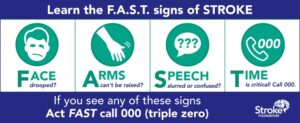We’ve enlisted our resident KompleteCare nurses for National Stroke Week to tell you about stroke prevention and risk factors.
National Stroke Week is all about raising awareness to provide education, support, and resources to help prevent stroke as well as aid in the recovery process for those who have had a stroke.
Strokes attack the brain and change lives in an instant. Injury to any area of your brain can affect how you think, speak, swallow, see, touch, and move your body.
What is a stroke?
A stroke occurs when blood cannot reach your brain due to a blocked or burst artery. Blood flow to the brain is crucial as it carries oxygen and nutrients, so when your brain cannot get the blood it needs, your brain cells die, and a stroke occurs.
Nurse Michelle explains there are two major types of strokes: Ischemic stroke and Hemorrhagic stroke.
Ischemic stroke is where blood clots or other particles block the blood vessels to the brain. Fatty deposits called plaque can also cause blockages by building up in the blood vessels.
Haemorrhagic stroke is when an artery in the brain leaks blood; the leaked blood puts too much pressure on brain cells, damaging them. High blood pressure and aneurysms are examples of conditions that can cause a haemorrhagic stroke.
How does a stroke affect the body?
Every stroke is different. The brain is divided into areas that control different parts of your body; therefore, a stroke’s effect depends on the damaged area of your brain. It also depends on how big the stroke is.
A stroke can affect many different areas of your body, including your emotions and how you think. A stroke can cause muscle weakness and speech, memory, hearing or vision issues.
Who is at risk of a stroke?
Stroke can happen to anyone and at any age, but men are at greater risk, and the risk increases with age.
Can I prevent a stroke?
Stroke prevention is possible for many; more than 80% of strokes can be prevented. We can help prevent them by managing any existing risk factors we have. Risk factors are things that can cause a stroke or increase their likelihood, and they are different for everyone.
Nurses Amandeep and Hannah have outlined the following major risk factors for a stroke:
- Obesity
- Physical inactivity
- Poor diet and unhealthy lifestyle
- Smoking and alcohol consumption
- High Blood Pressure
- High Cholesterol
- Type 2 Diabetes
- Atrial Fibrillation
- Previous stroke
- Age (risk increases as we age)
- Gender (men have a higher risk of stroke)
- Family history of stroke as well as the above medical conditions
- Heart conditions
- Blood conditions
- Genetic disorders
- Autoimmune disorders
- Medications such as blood thinners, hormone replacement, and oral contraceptives
- Pregnancy
- Illicit or illegal substances
- Trauma to the head
What can I do to reduce my risk?
You can help prevent and reduce your risk of a stroke by making healthy lifestyle choices and managing any health conditions you have. Nurses Michelle and Amandeep have outlined the following tips for stroke prevention and reducing your risk:
- Healthy Diet: Low-fat, high-fibre, plenty of fresh fruits, green vegetables and whole grains. Drinking plenty of water and eating a balanced diet is essential.
- Exercise: A combination of a healthy diet and regular exercise is the best way to maintain your health. Regular exercise helps to reduce cholesterol and keep blood pressure healthy. Even just a tiny walk a day can positively impact your health.
- Avoid alcohol consumption and cease smoking: Alcohol and Smoking are major risk factors for having a stroke. They affect the blood vessels by narrowing them, which reduces the blood flow or oxygen supply to the brain, leading to stroke.
- Managing underlying health conditions: Manage any health conditions you currently live with, especially any issues with cholesterol, blood pressure, diabetes and heart disease.
Familiarise yourself with the signs of a stroke.
The Stroke Foundation recommends the F.A.S.T. test as an easy way to remember the most common signs of stroke. Using the F.A.S.T. test involves asking these simple questions:
- Face: Check their face. Has their mouth drooped?
- Arms: Can they lift both arms?
- Speech: Is their speech slurred? Do they understand you?
- Time: is critical. If you see any of these signs, call 000 straight away.
The Stroke Foundation uses F.A.S.T. because if you notice any signs of stroke, you must act fast! A stroke is always a medical emergency, and the longer a stroke goes untreated, the greater chance of stroke-related brain damage.
While the above are the most common signs of stroke, there are also other signs you can look for. The following may occur alone or in conjunction with another sign:
- Weakness or numbness, or paralysis of the face, arm, or leg on either or both sides of the body
- Difficulty speaking or understanding.
- Dizziness, loss of balance or an unexplained fall
- Loss of vision, sudden blurring, or decreased vision in one or both eyes
- Headache, usually severe and abrupt onset, or unexplained change in the pattern of headaches
- Difficulty swallowing
It is important to remember that stroke is different for everyone. If you have any of the risk factors mentioned, it’s crucial that you take stroke prevention measures and do what you can to reduce your risk.
If you’re unsure whether you’re at risk, you can head to The Stroke Foundation’s website and take their “What is your stroke risk?” test. You can also test your risk on Stroke Riskometer for a more interactive test.
Please note – These are not conclusive tests but rather a guide to advise you on whether you should visit your doctor to discuss further.





